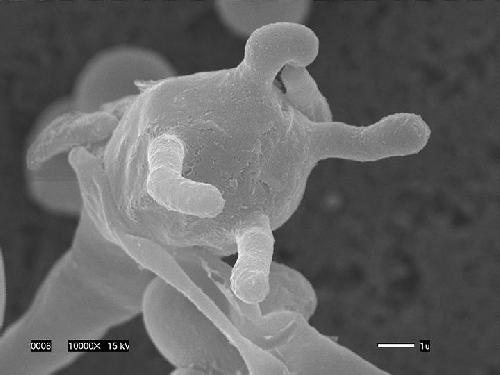DURHAM, N.C. -- For more than a decade, a rare but potentially deadly fungus called Cryptococcus deuterogatti has taken up residence in the Pacific Northwest and Vancouver Island. Unlike its cousin Cryptococcus neoformans, which mostly infects patients with compromised immune systems, this fungus has sickened hundreds of otherwise healthy people.
Now, researchers have found that the pathogen tossed aside over a dozen different genes on its way to becoming a new, more virulent species. Surprisingly, most of these discarded genes play a part in RNA interference or RNAi, a defense mechanism employed by fungi and other organisms to protect the integrity of their genomes. The study was published March 4 in PLOS Genetics.
"Genome instability is a bad thing in terms of human health, because it is linked to cancer and other diseases," said Blake Billmyre, lead study author and a graduate student in Joseph Heitman's lab at Duke University School of Medicine. "But it could be good thing for single-celled organisms like Cryptococcus, because it enables them to mutate, evolve and adapt to survive under different conditions."
 This image shows spores on the surface of a fruiting structure from the fungus Cryptococcus deuterogattii, a deadly strain that emerged in the Pacific Northwest. Credit: (Edmond Byrnes III, Joseph Heitman -- Duke Department of Molecular Genetics and Microbiology; Valerie Knowlton -- North Carolina State University, Center for Electron Microscopy)
This image shows spores on the surface of a fruiting structure from the fungus Cryptococcus deuterogattii, a deadly strain that emerged in the Pacific Northwest. Credit: (Edmond Byrnes III, Joseph Heitman -- Duke Department of Molecular Genetics and Microbiology; Valerie Knowlton -- North Carolina State University, Center for Electron Microscopy)
Cryptococcus deuterogatti was largely confined to tropical climates until 1999, when it showed up on Vancouver Island and began spreading throughout southwest Canada and into Washington and Oregon. The emerging fungal pathogen causes severe pulmonary and central nervous system infections, and is fatal if left untreated.
Five years ago, researchers in the Heitman lab participated in an international collaborative consortium to sequence the genome of this outbreak species and discovered that it had lost two genes involved in RNAi, a process previously thought to be key to its survival.
The RNAi gene-silencing machinery normally shreds the genetic instructions for harmful viruses or silences rogue genes that might contaminate the fungus' genome. But Cryptococcus deuterogatti had holes in its genome where the two RNAi genes should have been.
Armed with this information, Billmyre hypothesized that other genes in this missing set of genes might also function in RNAi. He and his colleagues compared the genomes of Cryptococcus deuterogatti with less potent cousins like Cryptococcus neoformans, which predominantly infects immunocompromised individuals. They found that C. deuterogatti has lost 14 genes compared to the other, less pathogenic, species.
The researchers then conducted a number of genetic and molecular analyses to determine if any of these lost genes played a role in RNAi. They mutated each of the genes in Cryptococcus neoformans, which has fully functioning RNAi machinery, to see if these genes were needed for the fungi to silence extra genetic material.
Joseph Heitman, the James B. Duke professor and chair of Molecular Genetics and Microbiology, said he expected to find maybe one or two other genes involved in RNAi. To his surprise, they found that 11 of the 14 missing genes they surveyed were involved in gene silencing.
"We could have imagined that the species lost a couple of RNAi genes, and then a smattering of genes involved in all other kinds of processes," said Heitman. "Instead, the one glaring difference between these more and less virulent species seems to be the loss of the RNAi pathway."
Though the researchers don't know why shedding the RNAi machinery could help Cryptococcus assume a deadlier form, they do have some ideas. It could enable the fungi to cohabitate with killer viruses that pump out powerful toxins to poison competing organisms. Or it could allow them to accumulate mutations or even extra chromosomes to gain resistance against antifungal medications.
Whatever the reason, the discovery could pave the way for future studies using comparative genomics to identify other sets of related genes. Once one gene in a pathway is lost, the researchers hypothesize that an organism can find itself on a slippery evolutionary slope as other genes that are no longer of benefit are lost in quick succession. Only a few other examples of this system-wide pattern of gene loss, called systems polymorphisms, have been described so far.
"There is so much you can learn from looking for things that are missing," said Billmyre. "It's true what they say, you don't know what you've got 'till it's gone."
source: Duke University